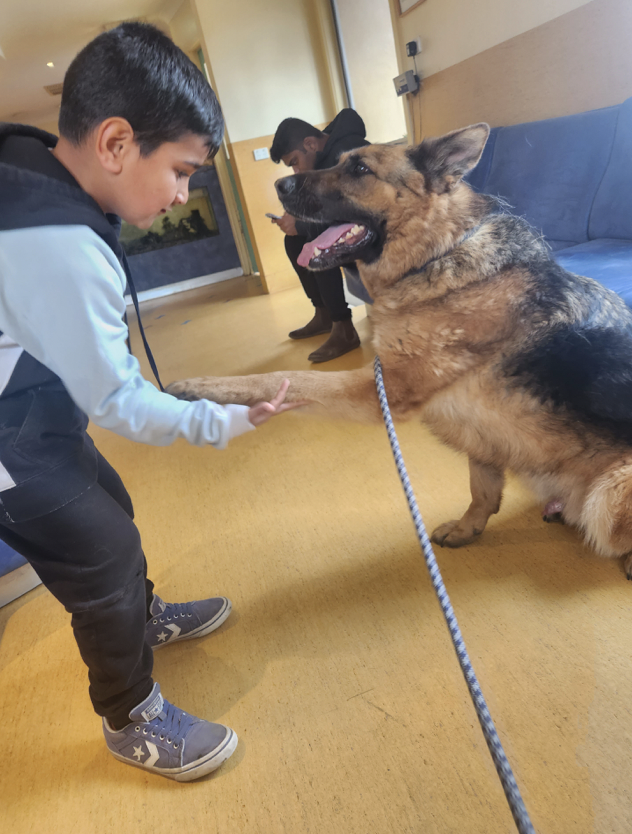By Donna Wild
Bringing a new canine companion into your life can be a thrilling experience, but it’s essential to ensure the introduction goes as smoothly as possible for all involved. At Into Loving Homes, we’re here to guide you through this process, and in this blog, we’ll cover the steps and considerations for introducing dogs to each other.
Factors that Influence Dog Interactions:
Many dogs have forgotten or never learned the art of proper canine greetings. They’re often on leashes, confined behind fences, or rushed into meetings, which can lead to misunderstandings. Tensions can arise, particularly when dogs are held on tight leashes, creating frustration and potential conflict with other dogs. Recognizable behaviors like pulling on a leash, hard stares, or overly excited approaches can sour these encounters.
Before setting up a dog introduction, it’s crucial to understand your dog’s general attitude toward other dogs. Each dog is an individual, with unique preferences and comfort levels. Some dogs may be uncomfortable with or reactive to new dogs, requiring slow and cautious introductions. Others may not necessarily like every dog they meet.
How to Introduce Dogs Properly:
First impressions matter, so introducing your current dog to a new one requires careful planning. Here’s a step-by-step guide to help ensure long-term success:
1. Walk Together: Enlist someone to accompany you on a walk, each of you handling one dog. Begin walking parallel to each other, initially maintaining a distance of around 20 feet. This step is crucial whether you’re collecting a new dog from their home or bringing them together for the first time.
2. Maintain Distance: If the dogs pull toward each other, engage in prolonged staring, or display excessive excitement, you’re too close too soon. Create more space between them and allow them to get acclimated before continuing the walk.
3. Use Treats: Reward both dogs for remaining calm and focusing on their handlers during the walk. Ensure you only reward behaviors you want to encourage, as treats won’t work if either dog has food aggression. Patience and a relaxed attitude are key, helping the dogs relax as well.
4. Observe Behavior: As the walk progresses, watch for signs of relaxed and confident behavior. Neither dog should appear overly aroused, nervous, stiff, or fearful. Keep in mind that achieving this level of comfort may take more than one walk.
5. Allow Sniffing and Play: If the dogs appear relaxed and interested in each other, you can allow them to get close enough to sniff and potentially play. Monitor their body language closely during these interactions, and be prepared to separate them if you observe signs of tension or aggression.
6. End on a Positive Note: Gradually introduce playtime, ensuring it remains calm and respectful. With your guidance, the dogs will have the opportunity to get to know each other and, hopefully, build a trusting bond. Always conclude play sessions on a positive and peaceful note.
Tricky Dog Introductions:
The procedure mentioned above is designed for introducing two social dogs to each other. If either dog displays on-leash reactivity or barrier reactivity (barking and lunging when leashed or behind a barrier), this method may not be suitable. In such cases, consulting a professional trainer or using safety gear like a muzzle may be necessary.
Supervising Dogs at Home:
When driving the dogs home after the introduction, place them in separate crates or vehicles to prevent unnecessary tension. At home, allow them to settle in, but remove toys, bones, and food bowls belonging to your resident dog to avoid potential conflicts.
While feeding or offering high-value items, it’s wise to separate the dogs initially. Over time, they may become more comfortable sharing these resources, but it’s essential to ensure their safety. When unsupervised, consider crating the new dog or placing them in separate rooms to prevent any potential issues.
When adopting through Into Loving Homes, you’ll have valuable insights into your adopted dog’s behaviour during introductions (because we have their history and access to them in their home and other environments) to your resident dog. However, remember that dogs are unique individuals, and any introduction should be approached with kindness and careful consideration. In the end, it’s about fostering a positive and harmonious relationship between your four-legged friends.

